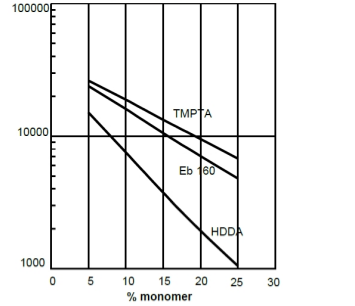Enhanced TDS
Identification & Functionality
- Base Chemicals Functions
- Blend
- No
- CASE Ingredients Functions
- Chemical Family
- Function
- Oligomer, Monomer
- Product Code
- MITM11984
- Single Ingredient
- Yes
- Technologies
- Product Families
Features & Benefits
- CASE Ingredients Features
- Labeling Claims
- Performance Highlights
EBECRYL® 221 is characterized by
- Light color
- Excellent cure response
UV/EB cured products based on EBECRYL® 221 are characterized by the following performance properties:
- High hardness and scratch resistance
- High solvent resistance
- High gloss
- Fast cure speed
The actual properties of UV/EB cured products also depend on the selection of the other formulation components, such as reactive diluent(s), additives and photoinitiators.
Applications & Uses
- Adhesive & Sealant End Applications
- Application Method
- Base Chemicals End Uses
- Coating End Applications
- Compatible Substrates & Surfaces
- Cure Method
- Ink & Toner End Applications
- Markets
- Applications
- Product Applications
Formulated UV/EB curable products containing EBECRYL® 221 may be applied by lithographic, screen, gravure, direct or reverse roll, and curtain coating methods.
EBECRYL® 221 is recommended for use in:- Wood coatings and fillers
- Lithographic inks
- Scratch resistant coatings on plastic
- Improving cure speed, solvent resistance and gloss
Properties
- Physical Form
Technical Details & Test Data
- Viscosity Reduction
EBECRYL® 221 can be diluted with reactive monomers such as 1,6- hexanediol diacrylate HDDA) product of allnex , trimethylolpropane triacrylate (TMPTA)(1) and trimethylolpropane ethoxy triacrylate (EBECRYL® 160) product of allnex . The specific reactive diluent(s) used will influence performance properties such as hardness and flexibility.
The graph shows the viscosity reduction of EBECRYL® 221 as a function of the concentration of different monomers.

Safety & Health
- Safety Precautions
The toxicological properties of this material have not been fully determined. Products of this type can be expected to be eye and skin irritant and have the potential to cause sensitization or other allergic responses. Appropriate precautions should be taken to avoid eye and skin contact and to avoid inhalation of the aerosols or vapors.
Packaging & Availability
- Packaging Type
Principal Information
- Group Principal Number
- S000001
- Principal
Storage & Handling
- Storage Conditions
- Care should be taken not to expose radiation curable products to temperatures exceeding 40°C for prolonged periods or to direct sunlight. This might cause uncontrollable polymerization of the product with generation of heat.
- Storage and handling should be in stainless steel, amber glass, amber polyethylene or baked phenolic lined containers.
- Do not store this material under an oxygen free atmosphere. Use dry air to displace material removed from the container. This material should not be stored for more than 2 years.
Other
- Appearance (SDS)
- Liquid resin
- Color (SDS)
- Yellowish
- IATA/ICAO Proper Shipping Name
- Environmentally hazardous substance, liquid, N.O.S.
- IATA/ICAO Technical name (N.O.S.)
- Mixture pentaerythritol tri/t/tetraacrylate
- IATA/ICAO UN Number
- UN3082
- IMO/IMDG Proper Shipping Name
- Environmentally hazardous substance, liquid, N.O.S.
- IMO/IMDG Technical name (N.O.S.)
- Mixture pentaerythritol tri/t/tetraacrylate
- IMO/IMDG UN Number
- UN3082
- Item Number
- Odor (SDS)
- Acrylate
- Other Hazards
- Polymerization may occur from excessive heat, contamination or exposure to direct sunlight .
- Protect from Freezing
- Yes
- TDG Canada Proper Shipping Name
- Environmentally hazardous substance, liquid, N.O.S.
- TDG Canada Technical name (N.O.S.)
- Mixture pentaerythritol tri/t/tetraacrylate
- TDG Canada UN Number
- UN3082
- Temperature Control
- Yes
- USA/DOT Proper Shipping Name
- Environmentally hazardous substance, liquid, N.O.S.
- USA/DOT Technical name (N.O.S.)
- Mixture pentaerythritol tri/t/tetraacrylate
- USA/DOT UN Number
- UN3082
- Mechanical Properties
Value Units Test Method / Conditions Tensile Elongation 1.0 % % Tensile Strength 31.0 MPa MPa - Optical Properties
Value Units Test Method / Conditions Color Scale max. 2.0 Gardner Gardner Gardner Color Scale - Physical Properties
Value Units Test Method / Conditions Density 1.22 g/cm³ g/cm³ Glass Transition Temperature (Tg) 49.0 °C °C Molecular Weight 1000.0 g/mol g/mol Storage Temperature 39.2-104.0 °F °F Viscosity 28500.0 mPa.s mPa.s at 25°C - SDS Physical and Chemical Properties
Value Units Test Method / Conditions Boiling Point (SDS) min. 100.0 °C °C Density (SDS) 1.21 g/cm³ g/cm³ Flash Point (SDS) min. 100.0 °C °C SetaFlash Closed Cup Vapor Pressure (SDS) max. 1.33 hPa hPa at 20°C Viscosity (SDS) 24500.0-325000.0 mPa.s mPa.s at 25°C, highly viscous liquid Volatile Content (SDS) max. 0.5 % % - Shelf Life & Stability
Value Units Test Method / Conditions Shelf Life 2.0 yr yr
